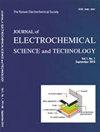Portable Amperometric Glucose Detection based on NiS/CuS Nanorods Integrated with a Smartphone Device
IF 3
4区 工程技术
Q3 ELECTROCHEMISTRY
Journal of electrochemical science and technology
Pub Date : 2023-06-02
DOI:10.33961/jecst.2023.00073
引用次数: 0
Abstract
Glucose detection is particularly important for clinical diagnosis and personal prevention and control. Herein, the smart-phone-based amperometric glucose sensors were constructed using the NiS/CuS nanorods (NRs) as sensing electrodes. The NiS/CuS NRs were prepared through a facile hydrothermal process accompanied by the subsequent vulcanization treatment. The morphological and structural properties of NiS/CuS NRs were characterized with SEM, EDS, XRD, and XPS. Electrochemical measurements including cyclic voltammetry, chronoamperometry, and electrochemical impedance spectroscopy display that NiS/CuS NRs can act as highly efficient electrocatalyst for glucose detection. The NiS/CuS NRs electrodes pres-ent a wide detection range of 1–8000 µM for glucose sensing with the sensitivity of 956.38 µA·mM -1 ·cm -2 . The detection limit was 0.35 µM (S/N=3). When employed in smartphone-based glucose sensing device, they also display a high sensitivity of 738.09 µA·mM -1 ·cm -2 and low detection limit of 1.67 µM. Moreover, the smartphone-based glucose sensing device also presents favorable feasibility in determination of glucose in serum samples with the recoveries ranging between 99.5 and 105.8%. The results may provide a promising viewpoint to design other new portable glucose sensors.基于智能手机集成NiS/ cu纳米棒的便携式安培血糖检测
血糖检测对临床诊断和个人预防控制尤为重要。在此,使用NiS/CuS纳米棒(NRs)作为传感电极构建了基于智能手机的电流型葡萄糖传感器。通过简单的水热工艺和随后的硫化处理制备了NiS/CuS-NRs。用SEM、EDS、XRD和XPS对NiS/CuS-NRs的形貌和结构进行了表征。包括循环伏安法、计时电流法和电化学阻抗谱在内的电化学测量表明,NiS/CuS-NRs可以作为葡萄糖检测的高效电催化剂。NiS/CuS-NRs电极对葡萄糖传感的检测范围为1–8000µM,灵敏度为956.38µa·mM-1·cm-2。检测限为0.35µM(S/N=3)。当用于基于智能手机的葡萄糖传感设备时,它们还显示出738.09µa·mM-1·cm-2的高灵敏度和1.67µM的低检测限。此外,基于智能手机的葡萄糖传感设备在测定血清样品中的葡萄糖方面也具有良好的可行性,回收率在99.5%至105.8%之间。该结果可能为设计其他新型便携式葡萄糖传感器提供一个有前景的视角。
本文章由计算机程序翻译,如有差异,请以英文原文为准。
求助全文
约1分钟内获得全文
求助全文
来源期刊

Journal of electrochemical science and technology
ELECTROCHEMISTRY-
CiteScore
6.30
自引率
8.10%
发文量
44
期刊介绍:
Covering fields:
- Batteries and Energy Storage
- Biological Electrochemistry
- Corrosion Science and Technology
- Electroanalytical Chemistry and Sensor Technology
- Electrocatalysis
- Electrochemical Capacitors & Supercapcitors
- Electrochemical Engineering
- Electrodeposition and Surface Treatment
- Environmental Science and Technology
- Fuel Cells
- Material Electrochemistry
- Molecular Electrochemistry and Organic Electrochemistry
- Physical Electrochemistry
- Solar Energy Conversion and Photoelectrochemistry
 求助内容:
求助内容: 应助结果提醒方式:
应助结果提醒方式:


